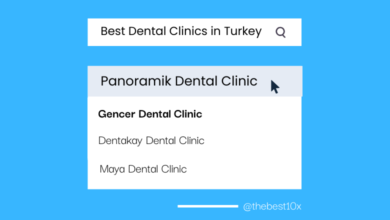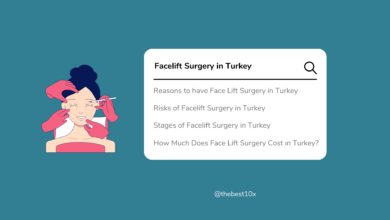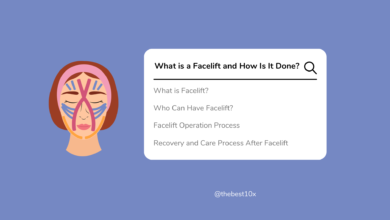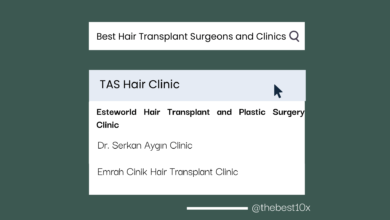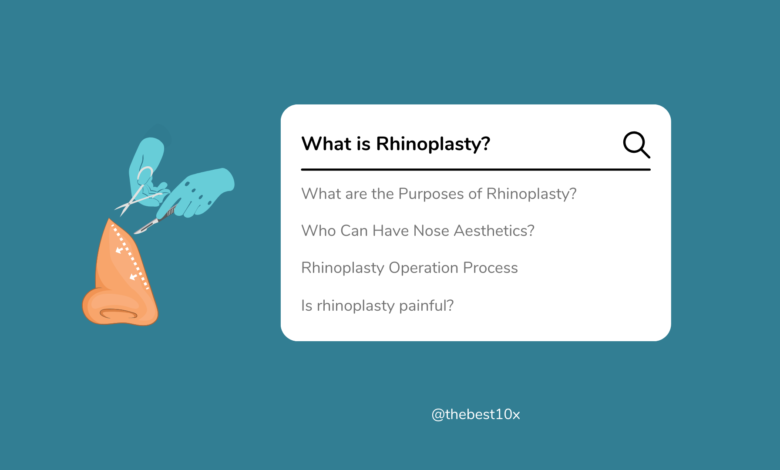
What is Rhinoplasty? How Is It Performed?
Aesthetics and beauty are important elements that increase people’s self-confidence. Located in the center of our face, the nose is one of the most important features that determine our appearance. Therefore, dissatisfaction or functional problems with the nose can negatively affect a person’s daily life. Fortunately, modern medicine and plastic surgery offer effective solutions that can correct such problems. In this blog post, we aim to inform readers about what rhinoplasty is, how it is performed and its different types. Rhinoplasty is a surgical procedure preferred both to add novelty to beauty with aesthetic concerns and to correct functional problems in the nasal structure, and offers the opportunity to achieve the results imagined with the right information and an experienced surgeon.
What is Rhinoplasty?
Rhinoplasty, also known as rhinoplasty, is a plastic surgery procedure. This operation aims to change the shape and size of the nose. While it is preferred both for aesthetic concerns, that is, to obtain a more beautiful and symmetrical nose; It can also be performed to correct congenital or acquired functional problems in the nasal structure.
Rhinoplasty improves the appearance of the nose by correcting and reshaping the bone and cartilage tissues of the nose. At the same time, problems such as curvatures in the nasal structure or nasal congestion are also corrected with this operation. Rhinoplasty is a very popular option for people who want to achieve a more harmonious and balanced nose appearance with other features of the face.
Aesthetically, rhinoplasty may include changes such as correcting the protrusions on the dorsum of the nose, changing the shape of the tip of the nose, adjusting the size of the nostrils and ensuring the overall symmetry of the nose. Functional rhinoplasty aims to eliminate breathing problems by correcting intranasal structures.
Rhinoplasty is performed by a specialized plastic surgeon and is planned by taking into account the expectations and anatomy of the person. The patient’s recovery process after the operation is important and acting in accordance with the doctor’s instructions is important to achieve successful results. As with any plastic surgery procedure, rhinoplasty requires a patient and conscious process for natural and harmonious results.
What Are The Purposes Of Rhinoplasty?
A beautiful face and aesthetic appearance is an important element that increases the self-confidence of individuals. In this process, the nose, located in the center of the face, plays a remarkable role. Having a naturally balanced and aesthetic nose structure provides a harmonious appearance with other features of the face. However, the shape and function of the nose can also be impaired by congenital or traumatic problems. Rhinoplasty is an effective surgical procedure that combines both aesthetic and functional improvements. In the following section, we will discuss the aesthetic and functional goals of rhinoplasty and provide detailed information on how this operation enhances the beauty and health of people.
Both aesthetic and functional goals of rhinoplasty are as follows:
Aesthetic Objectives
- Ensuring Symmetry and Harmony of the Nose: Rhinoplasty aims to ensure that the nose is harmoniously balanced with the other features of the face. Symmetrical nose is important for the overall aesthetics of the face.
- Changing the Shape of the Nose: Rhinoplasty allows the desired nose shape to be achieved by making changes such as correcting the protrusions on the back of the nose, changing the shape of the tip of the nose or adjusting the size of the nostrils.
- Improving Profile and Facial Harmony: Rhinoplasty can improve the profile and aesthetic appearance of the face. Corrections in the profile and regulation of the nose-respiratory tract relationship increase the balance of the face.
Functional Objectives
- Improvement of Breathing Problems: Some people may experience curvatures or obstructions in the nasal structures as a result of birth or trauma. Rhinoplasty can help improve nasal function by correcting breathing problems and reshaping the intranasal structures.
- Elimination of Sinus Problems: Chronic sinus problems can be treated by correcting intranasal structures and opening sinus cavities.
- Septum Correction: In patients who have breathing problems due to a curved septum (nasal septum), the septum is corrected and nasal functions are improved with a procedure called septoplasty.
Rhinoplasty, as a surgical procedure that can make aesthetic and functional improvements together, allows people to correct both their appearance and nasal functions. For this reason, it is important to consult with plastic surgeons and plan according to personal needs and expectations.
Who Can Have Nose Aesthetics?
People who want to have rhinoplasty are usually individuals who are not satisfied with their noses or who are uncomfortable due to functional problems in their noses. People who are considering rhinoplasty for aesthetic and functional reasons can have this procedure. Since the aim of rhinoplasty is to improve the appearance of the nose and to correct the nasal functions, it is possible for people to be suitable candidates in line with their expectations in both of these aspects.
You can examine the candidates who are and are not suitable for rhinoplasty according to the situation and criteria on the table below.
| Status / Criteria | Eligible Candidates | Ineligible Candidates |
| Aesthetic Concerns | – People who are not satisfied with their nose shape – People with nasal symmetry disorder and disproportionate size | -People who are not sure they want a change in the shape of their nose |
| Functional Problems | -People with intranasal curvature or obstruction in the nasal canal -People with breathing difficulties | – People with serious chronic health problems -Pregnant or lactating women |
| Trauma or Injuries | – People with nasal deformation as a result of trauma | -People with chronic infections |
| Age Factor | – People with complete nasal development | – Children with incomplete nasal development |
| Health Status | – People who do not have a health condition that may prevent surgery | -People with blood clotting problems, people who use blood thinners -People with heart disease and high blood pressure |
| Realistic Expectations | -People who expect realistic results from surgery | -People who expect surreal results from surgery should think again as they may be unhappy afterwards. |
| Psychological Preparation | -People who are psychologically prepared for surgery and postoperative period | -People who have not prepared their psychology for the operation process, those who are in the process of psychological treatment. |
Rhinoplasty Operation Process
Rhinoplasty is an effective surgical procedure that responds to the aesthetic and functional needs of individuals. The operation is performed by a specialized plastic surgeon and aims to address both aesthetic concerns and correct nasal functions. Here are the steps of the rhinoplasty operation process:
- Pre-Operational Consultation and Evaluation Process
Before deciding on a rhinoplasty operation, it is important to consult with a specialized plastic surgeon. In this process, the surgeon listens to the patient’s aesthetic concerns and expectations, evaluates the nasal structure and determines the appropriate treatment options, taking into account the health status of the person. It is assessed whether the patient is a suitable candidate for surgery and the operation is planned.
- Anesthesia Preferences and Operation Day Preparations
Rhinoplasty is usually performed under general anesthesia, but local anesthesia may be preferred in some cases. Before the day of the operation, the patient must follow the specific preparation instructions given by the surgeon. There are some important rules, such as being hungry and avoiding alcohol and smoking. All necessary preparations are completed to make the patient feel comfortable and safe.
- Step by Step Realization of Rhinoplasty Operation:
The rhinoplasty operation usually takes about 1-3 hours and takes place in line with the corrections and improvements planned by the surgeon. During the operation, the nasal bones and cartilage structures are precisely shaped. The surgeon works diligently to create a nasal appearance that will meet the patient’s aesthetic expectations. After surgery, stitches are placed and a cast or splint is applied over the nose.
After the rhinoplasty operation, the healing process begins and it is important that the patient follows the instructions recommended by the surgeon. Swelling and bruising are normal during this process and will decrease over time. When the healing is complete, the person will have a more aesthetic and balanced nasal structure and improved nasal functions.
Types and Usage Areas of Rhinoplasty
This surgical procedure, which is performed to harmonize the nose with aesthetic concerns and to correct nasal functions, aims to beautify one of the most striking features of individuals’ faces. While rhinoplasty operations performed with aesthetic concerns eliminate dissatisfaction with the shape, size and symmetry of the nose, functional rhinoplasty eliminates respiratory problems by correcting the functionality of the nose. In addition, combined aesthetic and functional improvements aim to meet aesthetic and functional needs together by offering customized solutions to people in both areas. Below, we have explained how these important surgical procedures contribute to people and how they are performed safely by discussing the types and usage areas of rhinoplasty.
- Rhinoplasty Operations Performed with Aesthetic Concerns:
Rhinoplasty procedures in this category aim to address aesthetic concerns about the shape, size or symmetry of individuals’ noses. People who consider rhinoplasty for aesthetic reasons prefer such operations to make their noses more beautiful and harmonious and to achieve a more harmonious appearance with their faces.
- Rhinoplasty (Septoplasty) for the Correction of Functional Problems:
Rhinoplasty is a surgical method that aims to correct problems related to nasal functions as well as nasal aesthetics. People with functional problems such as curvatures of the intranasal structures, nasal congestion or breathing difficulties can correct their nasal functions and provide a more comfortable breathing with rhinoplasty operation.
- Combined Aesthetic and Functional Improvements:
Such rhinoplasty operations aim both to eliminate aesthetic concerns and to correct nasal functions. It offers customized solutions for both aesthetic and functional needs of individuals. Combined operations are performed in collaboration between plastic surgeons and ENT specialists and aim to restore both aesthetic appearance and nasal functions in the best way.
Types of rhinoplasty differ according to the needs of each individual and the evaluation to be made by a specialist plastic surgeon is critical in determining the most appropriate method. While operations performed with aesthetic concerns improve the aesthetic appearance of the nose, functional rhinoplasty helps to solve breathing problems by improving nasal functions. Combined aesthetic and functional improvements are an effective option that provides optimal results in both areas.
Differences Between Closed and Open Rhinoplasty
Rhinoplasty is an important branch of aesthetic surgery that includes different techniques for individuals’ aesthetic concerns and the need to improve nasal functions. Closed and open rhinoplasty techniques stand out among these surgical methods. Closed rhinoplasty is a method performed with incisions made inside the nose and does not leave any external scar. Open rhinoplasty is a method performed with a small incision at the tip of the nose and provides the surgeon with a wider angle of vision. Both methods have their own advantages and usage areas, and the appropriate method is determined according to the experience of the plastic surgeon and the needs of the patient. In the rest of the content, we will examine the differences between closed and open rhinoplasty in more detail and help people understand which method is more suitable for them.
Closed Rhinoplasty:
- It is a method in which rhinoplasty surgery is performed through incisions in the nose.
- It does not leave any external scars, so the surgical scars are less noticeable.
- The procedure is performed on the nasal bone and cartilage structures.
- Since there is less tissue trauma, the healing process can be faster.
- Swelling and bruising may be less visible.
- Since the surgeon’s field of view is more limited, the opportunity for detailed examination and correction may be limited.
Open Rhinoplasty
- It is a method performed by making a small incision at the tip of the nose in rhinoplasty surgery.
- Surgical scars may be more prominent, but the incision line heals over time and becomes less noticeable.
- Opening the entire nose during surgery provides the surgeon with a wider angle of vision.
- It can be preferred especially for complex revision surgeries and functional corrections.
- It can help the surgeon achieve the desired results by providing more control and precision.
It should not be forgotten that closed and open rhinoplasty techniques are preferred according to the needs of the patient and the surgeon’s expertise. Both methods have their own advantages and disadvantages. When planning rhinoplasty surgery, the most appropriate method should be determined by considering the patient’s condition and expectations. The experience and expertise of the plastic surgeon plays a critical role in the successful realization of the surgery.
Determining the Most Suitable Method According to the Preference of the Aesthetic Surgeon
In rhinoplasty surgery, the experience and preferences of the plastic surgeon are important when choosing between closed and open rhinoplasty techniques. The most appropriate method for each patient is determined by the patient’s nasal structure, aesthetic goals and the surgeon’s expertise. The surgeon aims to meet the aesthetic expectations of the patient and successfully perform functional corrections by performing the procedure with the most appropriate technique for the patient’s needs.
Closed and open rhinoplasty techniques are effective methods used in rhinoplasty surgeries in accordance with different situations and needs. Both methods have their own advantages and areas of use, and the most appropriate method is determined according to the needs of the patient with the evaluation of the plastic surgeon.
Recovery and Care Process After Rhinoplasty
The recovery and care process after rhinoplasty is important to ensure that the patient recovers in a comfortable and healthy way after the successful completion of the operation. Taking careful and correct steps in the postoperative period plays a critical role in achieving the desired results and preventing complications. Here is what you need to know about the healing and care process after rhinoplasty:
First 24 Hours: The first 24 hours after surgery are spent under observation in the hospital. The plaster placed on the nose and the plugs in the nose are left for protective purposes. It is important to rest and pay attention to the lying position.
Swelling and Bruises: Swelling and bruises are normal after the operation. This usually subsides within 1-2 weeks. It is possible to relieve swelling by applying a cold compress.
Pain and Discomfort: Mild pain and discomfort after surgery is normal. You can get relief by using painkillers recommended by your doctor.
Nose Care: You should regularly perform nasal cleaning and care as recommended by your doctor. Keeping the nose moist helps prevent crusts and dryness.
Nutrition and Activity: After the operation, it is important to follow a light diet and avoid excessive physical activity. You should avoid heavy exercise for the period recommended by your surgeon.
Doctor Check-ups: It is important to go to regular doctor visits in the postoperative period. Your doctor will follow your recovery and answer any questions you may have.
Sun Protection: It is important to take care to protect from the sun after the surgery, to preserve the color of the plaster on the nose and to protect the nasal area from harmful effects.
Remember that each individual’s healing process may differ. Strictly following your doctor’s instructions and reaching out to your doctor when necessary is one of the most important steps for a healthy and successful recovery. Care and careful behavior after rhinoplasty will help you achieve the aesthetic and functional results you want.
Postoperative Bandage and Tampon Use
After the rhinoplasty operation, bandages placed on the nose and tampons placed inside the nose are used to maintain the shape of the nose and support the healing process. Bandages and tampons help reduce swelling and allow the nose to settle. It is important to use these bandages and tampons for the period determined by your doctor in the postoperative period.
Expected Effects and Considerations in the Recovery Process
Certain effects and healing processes are expected after rhinoplasty. Especially swelling, bruising, mild pain, crusting in the nose are normal. Using the medications recommended by your doctor, regular intranasal care, sleeping with the head elevated and avoiding heavy physical activities are important steps to support the healing process.
Post-Operative Controls and Counseling Options
Regular postoperative check-ups allow your doctor to monitor the outcome of the operation and quickly resolve any problems. Controls contribute to a healthy and successful recovery process. They are also offered counseling options to ask questions and share concerns throughout the patient’s recovery process. Regular communication with your doctor will help the process go more smoothly.
Frequently Asked Questions
Is rhinoplasty painful?
Mild pain and discomfort may be felt after the operation, but these pains are usually manageable and subside in a short time.
How long are bandages and tampons used after rhinoplasty?
The bandage is usually used for 1 week and the tampons for 1-3 days. However, these times may vary depending on your surgeon’s preferences and the healing condition of the nose.
Does rhinoplasty surgery leave scars?
The closed rhinoplasty technique usually does not leave a visible scar. In the open rhinoplasty technique, a minimal scar may remain due to the small incision at the tip of the nose.
When will the swelling and bruising after rhinoplasty disappear?
Swelling and bruising usually subsides within 1-2 weeks. In the first weeks, applying cold compresses can relieve swelling.
How long does a rhinoplasty operation take?
The rhinoplasty operation can usually be completed in 1-3 hours.
Which conditions are required to be a suitable candidate for rhinoplasty?
Suitable candidates are people with a healthy body structure and realistic expectations from rhinoplasty surgery. Those who are in poor health or psychologically unable to tolerate the surgery are not suitable candidates.
Can nasal curvature occur again after rhinoplasty?
Rhinoplasty performed by a specialized surgeon usually gives permanent results. However, in rare cases it is possible for the curvature to reoccur.
When can revision rhinoplasty be performed?
Revision rhinoplasty can be performed after a full recovery period after the first surgery and with the approval of your doctor. This is usually considered after 1 year.
As mentioned throughout the content, since rhinoplasty is an operation that will change one of the most prominent and striking features of a person’s face, the choice of surgeon is of great importance. Choosing the right surgeon is vital for achieving the desired results and minimizing the risk of complications. An expert and experienced plastic surgeon makes a personalized planning by understanding the needs of the person and performs the surgery in the safest way. When choosing a surgeon, it is important to pay attention to their references, experience and achievements and make the right decision that will increase your satisfaction after surgery. In this context, researching the best rhinoplasty surgeon before surgery is a critical step you will take in this regard.

